
Director, Book Publishing, Robert Anthony; Managing Editor, BookPublishing, Abe Ogden; Editor, Rebekah Renshaw; Production Manager, Melissa Sprott; Composition, Circle Graphics; Cover Design, Michele de la Menardiere; Printer, United Graphics, Inc.
2009 by the American Diabetes Association, Inc. All Rights Reserved. No part of this publication may be reproduced or transmitted in any form or by any means, electronic or mechanical, including duplication, recording, or any information storage and retrieval system, without the prior written permission of the American Diabetes Association.
Printed in the United States of America
1 3 5 7 9 10 8 6 4 2
The suggestions and information contained in this publication are generally consistent with the Clinical Practice Recommendations and other policies of the American Diabetes Association, but they do not represent the policy or position of the Association or any of its boards or committees. Reasonable steps have been taken to ensure the accuracy of the information presented. However, the American Diabetes Association cannot ensure the safety or efficacy of any product or service described in this publication. Individuals are advised to consult a physician or other appropriate health care professional before undertaking any diet or exercise program or taking any medication referred to in this publication. Professionals must use and apply their own professional judgment, experience, and training and should not rely solely on the information contained in this publication before prescribing any diet, exercise, or medication. The American Diabetes Associationits officers, directors, employees, volunteers, and membersassumes no responsibility or liability for personal or other injury, loss, or damage that may result from the suggestions or information in this publication.
 The paper in this publication meets the requirements of the ANSI Standard Z39.481992 (permanence of paper).
The paper in this publication meets the requirements of the ANSI Standard Z39.481992 (permanence of paper).
ADA titles may be purchased for business or promotional use or for special sales. To purchase more than 50 copies of this book at a discount, or for custom editions of this book with your logo, contact the American Diabetes Association at the address below, at book sales@diabetes.org, or by calling 703-299-2046.
American Diabetes Association
1701 North Beauregard Street
Alexandria, Virginia 22311
Library of Congress Cataloging-in-Publication Data
Type 2 diabetes: your healthy living guide: tips, techniques, and practical advice for living well with diabetes.4th ed.
p. cm.
Includes bibliographical references and index.
ISBN 978-1-58040-286-6 (alk. paper)
eISBN 978-1-58040-381-8
1. Non-insulin-dependent diabetesPopular works. I. American Diabetes
Association. II. Title: Type two diabetes.
RC660.4. T97 2009
616.4'62dc22
2008055048
Table of Contents
Type 2 Diabetes: Your Healthy Living Guide, Fourth Edition has been updated and expanded to provide you with all the latest information you need to live a healthy life with diabetes. It takes you through the basics of what diabetes is, gives you tips on medical care, and how to make a plan to care for your diabetes. Youll learn about the newest meal-planning tools and medications and whats expected of you and your health care providers in monitoring your health. Youll find out how to steer clear of diabetes complications, fit diabetes into you lifestyle, and navigate your way through the emotional ups and downs of living with diabetes.
Type 2 Diabetes: Your Healthy Living Guide, FourthEdition gives you the tools and techniques youll need to help you meet the challenge of diabetes. By meeting the challenges you face, you will improve your diabetes control and your overall health. Be sure to ask your health care providers for help when you need it, and try your new-found skills every chance you get. Your reward will be your better health, today and tomorrow.
Many thanks to the reviewers of this book:
Marilynn S Arnold, MS, RD, LD, CDE
Dayton Childrens Medical Center
Dayton, Ohio
Virginia Peragallo-Dittko, RN, BC-ADM, MA, CDE
Director, Diabetes Education Center
Winthrop-University Hospital
Mineola, NY
Stephanie Dunbar, RD, CDE
American Diabetes Association
Alexandria, Virginia
Introduction to
Type 2 Diabetes
I f youve recently been diagnosed with type 2 diabetes, you probably have a lot of questions. Thats goodfinding out more about the disease is an important step in learning how to manage it. Throughout this book, youll learn about a lot of things you may not even have thought of yethow to build a meal plan, how to deal with diabetes complications, and how medications fit into a care plan. But for now, lets talk about the basics. Here are some questions you may haveand some answers.
Diabetes is a chronic disease that affects your bodys ability to change food into energy. Every part of your body needs energy to do its work, just like a car needs gasoline to run. Thats why diabetes can make you feel tired or not quite yourself. Even if you feel fine, running on less gas affects nearly every part of your body.
Heres how it works: After you eat a meal, your body breaks your food down into many parts. One of those is glucose, a type of sugar. Glucose is the fuel that your body uses for energy.
Glucose travels to cells everywhere in your body through the bloodstream; however, glucose cant get into hungry cells without a hormone called insulin. Insulin is made by special cells called beta cells in an organ called the pancreas. Insulin is stored in the pancreas until it is needed. When glucose levels in your blood start to go up after you eat, the pancreas releases insulin to help glucose get into cells throughout the body. Think of insulin as the key that opens the door so glucose can get into the cells and make energy.
People with diabetes either cant make enough insulin, or their bodies cant use it effectively. Without insulin, glucose cant get into the cells, and the cells run out of energy. Over time, those hungry cells become damaged, and glucose builds up in the bloodstream, with nowhere to go.
There are two kinds of diabetes. In type 1 diabetes, the beta cells in the pancreas dont produce any insulin at all. This is why people with type 1 diabetes must replace insulin through injection to live.
Type 2 diabetes happens when the beta cells dont make enough insulin, or the body doesnt use the insulin effectively. A person with type 2 diabetes might add insulin over time, as one of many therapies.
Both types of diabetes can cause other health problems. Over time, the buildup of glucose in the bloodstream and the lack of energy supplied to cells can hurt your eyes, kidneys, nerves, heart, and blood vessels.
Type 2 diabetes is much more common than type 1. About 24 million Americans have diabetes and most of them9 out of 10have type 2.
Diabetes in the U.S.
- 24 million people in the U.S. have diabetes.
- 9095% have type 2 diabetes.
- 510% have type 1 diabetes.
- Nearly 8% of the total population has diabetes.
- 23% of people age 60 or older have diabetes.
Source: Real-Life Guide to Diabetes (ADA, 2009)
Researchers arent sure what causes type 2 diabetes. They do know that you cant catch it from someone else, like you can the flu. They know it isnt caused by eating too much sugar. Type 2 diabetes is not a simple disease. You cant pinpoint the one thing that caused your diabetes, because it probably wasnt just one thing.
Next page


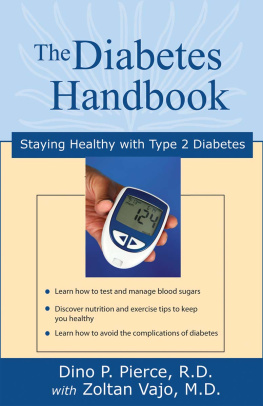
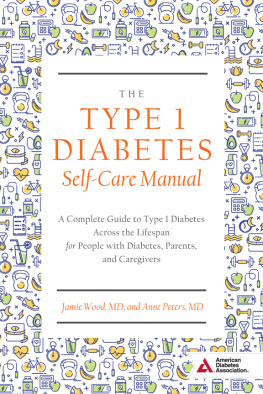
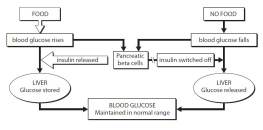
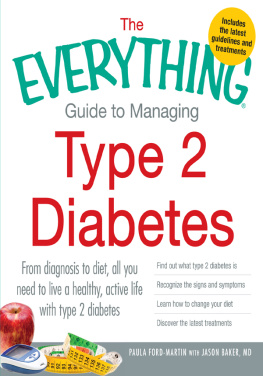

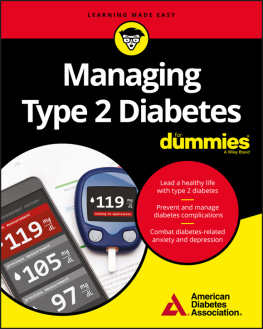




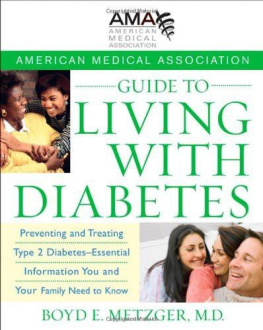

 The paper in this publication meets the requirements of the ANSI Standard Z39.481992 (permanence of paper).
The paper in this publication meets the requirements of the ANSI Standard Z39.481992 (permanence of paper).